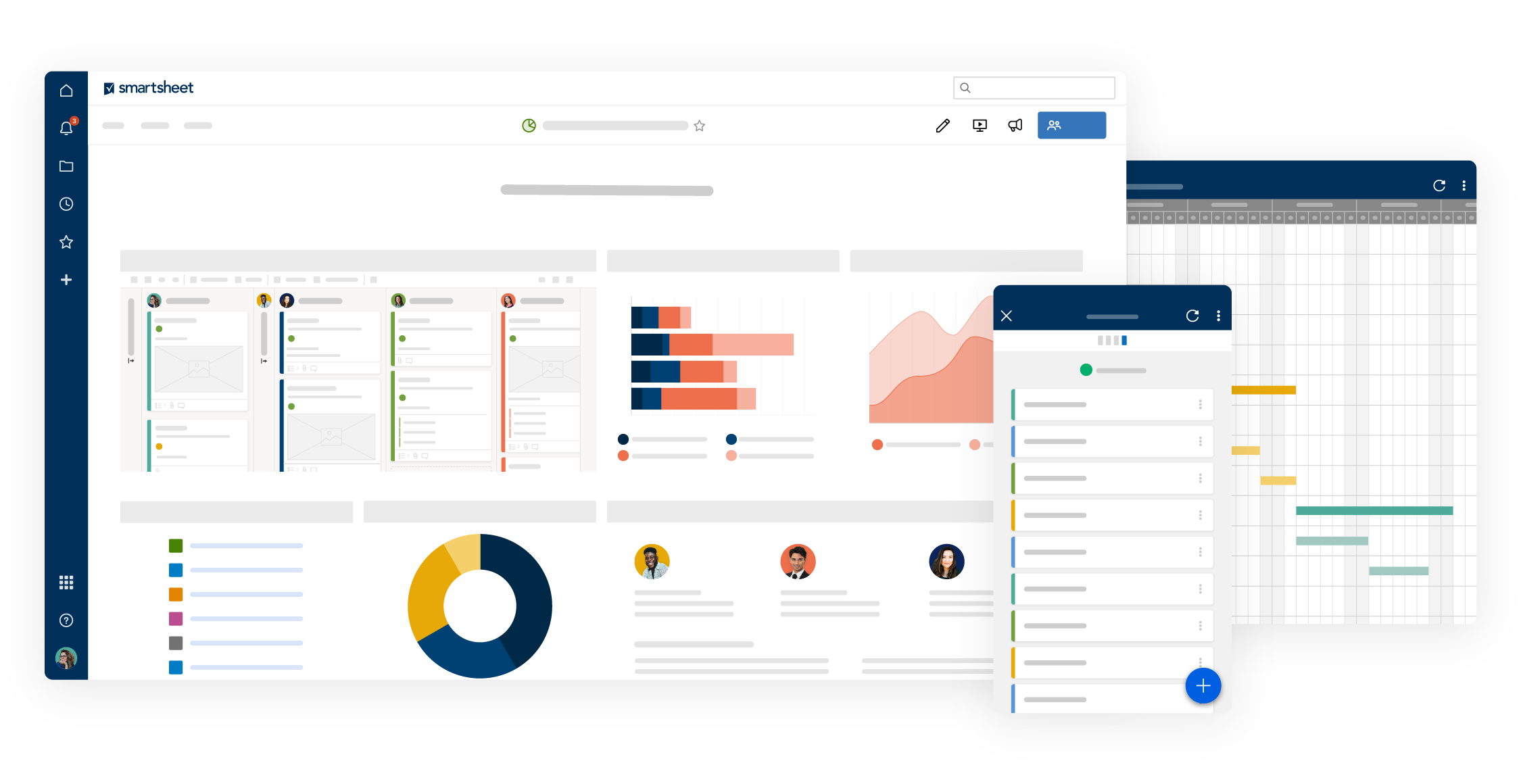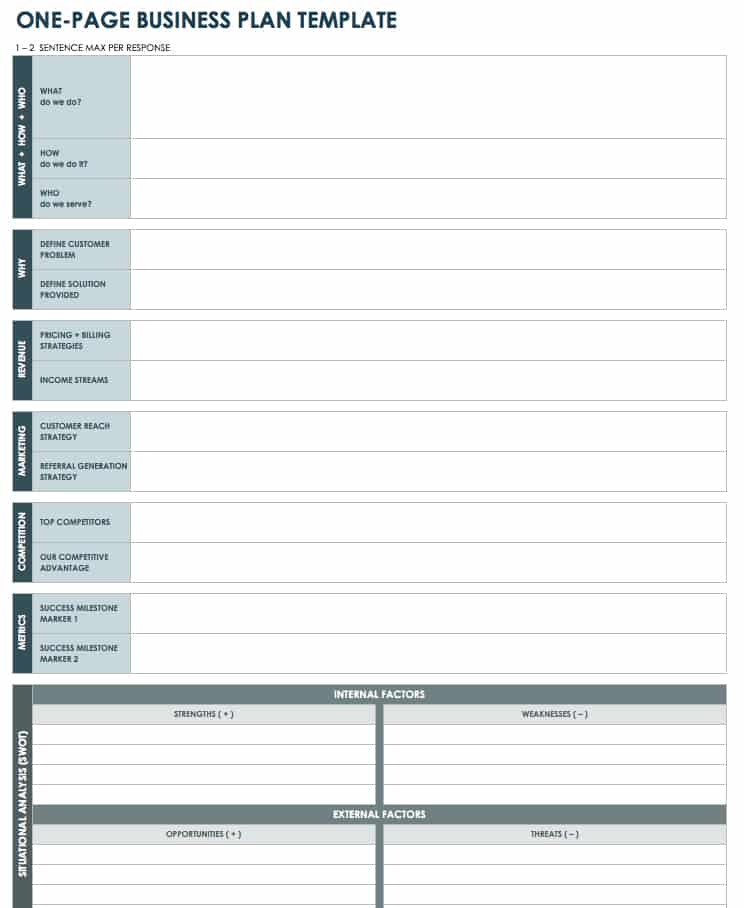
Approachable pitch — Having a one-page plan makes it easier to share, even if you’re not pitching in front of investors. You can quickly send it as an email attachment, throw it into a slide deck and even have it printed off as an easy read for interested parties.
The one-page business plan is a simplified version of traditional operational plans that focuses on the core aspects of your business. While it may be a shorter business plan, it still follows the structure of a standard business plan template and serves as a beefed-up pitch document.
Simple presentation — Investors don’t have lots of time to read and one page can get the idea of your business across quickly and succinctly.
If you feel like you have writer’s block, or you don’t know where to start, I have a couple of suggestions.
The benefits of a one page business plan
Don’t get me wrong—you don’t want to have an ugly presentation. But focus on the content, because it’s more important than anything else, and visuals can be reviewed and revised at a later date.
Third, you can try out LivePlan’s Pitch feature . Just answer the questions it asks and click “publish,” and you’ll have a professionally designed, single-page business plan that is easy to share and covers everything an investor wants to know. Another good option is to follow my colleague Caroline Cummings’ advice and write your business plan like it’s a series of tweets (seriously, it works).
Focus on what’s important — It’s actually a very good exercise to trim it down to the absolute minimum, and doing so forces you to trim needless words and communicate your business idea clearly, with minimal clutter.

- Access to Free Entrepreneur Toolbox app
- Teen Portfolio Book
- DVD of Anthony’s Training Video
- Parent’s Guide Book
- Pack of Thank You Cards
- Deck of Conversation Starter Cards about Starting a Business
- Goal Tracker Poster
Then you’ll definitely want my free Take Your Child to Work Day printables – it’s got a section for you to fill in about your own business, which is a perfect business plan example to discuss with your child.
They’re not entirely kid-friendly, but can give lots of ideas for the kind of information and research to put into a business plan.
For example, I raise the question of how much it will cost to not only create the product/service, but to also deliver it and maintain it. These are sometimes costs forgotten costs when creating a business plan.
6. Boss Club Kid Entrepreneur Kit

- Your child can play around with it and get familiar with what's required (even if they never start the business)
- It helps kids focus on just one business idea at time, and to see if they should move forward with it
Ready for this? You can actually get an entire business-in-a-box (including a business plan example, and full guide on starting a business) for your child.
- Homemade Dog Treats business
- Luxury Bath Bombs business
- Gourmet Cake Pops business
In other words, it’s so much more than just a business template for kids!
We'll also send you updates on new educational guides and success stories from the Shopify newsletter. We hate SPAM and promise to keep your email address safe.
- Know your audience. If you’re writing a business plan for yourself in order to get clarity on your ideas and your industry as a whole, you may not need to include the same level of detail or polish you would with a business plan you want to send to potential investors. Knowing who will read your plan will help you decide how much time to spend on it.
- Know your goals. Understanding the goals of your plan can help you set the right scope. If your goal is to use the plan as a roadmap for growth, you may invest more time in it than if your goal is to understand the competitive landscape of a new industry.
- Take it step by step. Writing a 10- to 15-page document can feel daunting, so try to tackle one section at a time. Select a couple of sections you feel most confident writing and start there—you can start on the next few sections once those are complete. Jot down bullet-point notes in each section before you start writing to organize your thoughts and streamline the writing process.
We’ve filled out a sample business plan as a companion to our template, featuring a fictional ecommerce business. We’ve noted where—and how—an entrepreneur could add more details to expand on their plans, depending on their goals.
- No blank-page paralysis. A blank page can be intimidating to even the most seasoned writers. Using an established framework and guidelines can help you get past the inertia of starting your business plan, and it allows you to skip the work of building an outline from scratch. You can always adjust a template to suit your needs.
- Guidance on what to include in each section. If you’ve never sat through a business class, you might never have created a SWOT analysis or a balance sheet before. Templates that offer guidance—in plain language—about how to fill in each section can help you navigate sometimes-daunting business jargon and create a complete and effective plan.
- Knowing you’ve considered every section. In some cases, you may not need to complete every section of a startup business plan template, but its initial structure shows you you’re choosing to omit a section as opposed to forgetting to include it in the first place.
Free: Business Plan Template

You’re already investing time and energy in planning your small business—there’s no need to reinvent the wheel when it comes to formatting your plan. Instead, to help build a complete and effective plan, lean on time-tested structures created by entrepreneurs and startups who have come before you.
- Executive summary. A one-page summary of your whole plan, typically written after the rest of the plan is completed.
- Company description. An overview can include many potential sub-sections, from the basics (your type of business model) to the meaningful (your business’ vision and mission statement).
- Market analysis. Everything from estimated market size to your target markets. It’ll also include a competitive analysis of your industry to address competitors strengths and weaknesses.
- Products and services. What you sell and the most important features of your products or services. It’ll also include any plans for intellectual property, like patent filings or copyright. If you do market research for your products, it’ll show up in this section of your business plan.
- Marketing plan. How you intend to get the word out about your business, and what strategic decisions you’ve made about things like your pricing strategy.
- Logistics and operations plan. Everything that needs to happen to turn your raw materials into products and get them into the hands of your customers.
- Financial plan. It’s important to include a look at your financial projections. This section includes templates for three key financial statements: an income statement, a balance sheet, and a cash-flow statement.
In our business plan template, each section includes an overview of the most important information to cover and guidelines on how to approach writing and researching each one.
Business planning is often used to secure funding, but plenty of business owners find writing a plan valuable, even if they never work with an investor. That’s why we put together a free business plan template to help you get started.

Download One-Page Business Plan for Nonprofit Organization Template
Use this one-page business plan template — designed to be simple, organized, and easy to use — to immediately get started on your plan. Write down your thoughts and key ideas as you decide if your business concept is viable, and adjust it as circumstances change. You can also use this template as a basis to build a more detailed and elaborate plan.
Since a one-page plan omits many of the details provided in a traditional business plan, be sure you have market research and other supporting documentation on hand to show stakeholders in case they have questions as they review your plan. In addition, make sure you thoroughly understand the supporting information and know how to restate it in your own words before you disburse the plan.
In this article, we’ve gathered a variety of free, one-page business plan templates for you to download in Excel, Word, and PDF formats.
See how Smartsheet can help you be more effective

- Push you to prioritize and focus on key ideas.
- Enable your audience to quickly scan and grasp the core concepts of your plan.
- Allow you to easily share and pitch your business idea to prospective investors and stakeholders (e.g., email attachment, single piece of paper).
- Accelerate business setup, especially businesses that don’t need a loan or investment to get going.
- Provide a solid starting point to expand upon at a later time.
- Enable you to document your thoughts and ideas to see if you have a feasible plan.
- Ensure your plan answers all the vital questions.
Compile all the current information you have gleaned from market research, interviews, surveys, and various teams in your business (e.g., the marketing and finance teams). Comb through each document and extract the information that is fundamental to your business’s operation and relevant to the bullet points on your outline.
- It is required by many business regulators, investors, and stakeholders.
- It provides a sense of security for managers and staff.
- It will allow your business to provide reasonable service to your customers during and after an emergency.
- It will allow you to preserve your revenue stream and your reputation.
- It can provide additional insight into your organization.
Post Jobs for FREE
- Completely free trial, no card required.
- Reach over 250 million candidates.
Download this business continuity plan template in MS Word format and start using it straight away.
In times of crisis, having a business continuity plan in place will ensure your business is able to function, before, during, and after an emergency event.
Why is it Important To Have a Business Continuity Plan?

A BCP will clearly outline the people and procedures involved in running your business when the worst happens. A Busines Continuity Plan is beneficial because:
The COVID-19 (Coronavirus) pandemic is a real-world example of an emergency situation in which a business continuity plan should be instituted. We've got a COVID-19 specific business continuity plan as well.
Emergency events can also include natural disasters, workplace violence, utility failures, cyber-attacks, supply shortages, economic downturns, or any event that will result in the disruption of business processes.
A business continuity plan (BCP) is an essential business document that outlines how a business will continue its critical functions during and after an emergency event or disruption in business.

